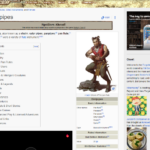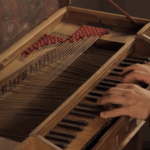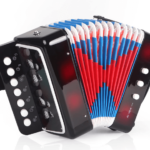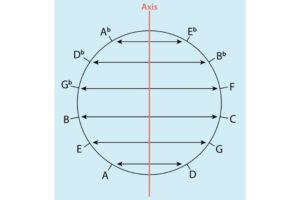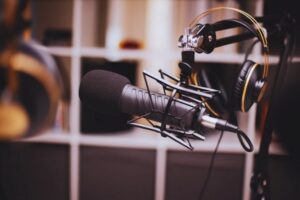Ornamentation, in music, is intended to form expressive melodies and allow musicians to showcase their skills. One example of ornamentation is the grace note, which has two types: the appoggiatura and the acciaccatura. In this article, you’ll learn more about these interesting-sounding decorative notes.
The acciaccatura is a grace note that’s closely related to the appoggiatura. It features an auxiliary note marked as a grace note with a diagonal line that slashes through the stem that precedes a principal note. While a properly played appoggiatura emphasizes the grace note, the acciaccatura emphasizes the principal note.
Read on to learn more about the appoggiatura and the acciaccatura grace notes, including their history, differences, and how they’re notated.
What Are Grace Notes?
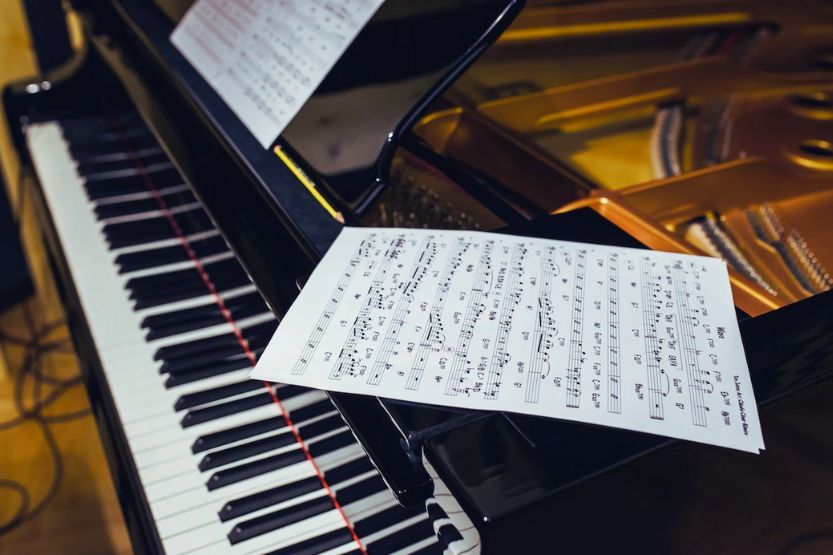
Separates the Intermediate and Advanced Musicians from the Beginners
A grace note separates the intermediate and advanced musicians from the beginners. It’s a short-lived note that mainly acts as ornamentation for the principal note (or main note) that comes before it.
Ornamentation Makes a Musical Piece More Expressive
In music, ornamentation is added to a complete musical piece to make it more expressive, pleasant sounding, and complex.
Should Be Played Quickly
Unlike other notes with a short duration (e.g., sixteenth notes and thirty-second notes), musicians should quickly play the grace notes to lead to the real note. However, musicians don’t change the tempo of a musical piece in the overall time value of the measure.
Marcato – Music Definition – What Does Marcato Mean in Music?
Short History of Grace Notes
Surged in Popularity During the Early Baroque Era of Music
There’s not much detail about the history of appoggiatura and acciaccatura grace notes. Their use most likely surged in popularity during the early Baroque era of music, which was around the 16th century and peaked in the 18th century.
Divided Into Two Categories During Bach’s Time
By the time of Johann Sebastian Bach (between the 14th and 16th centuries), it was already divided into two categories based on length:
- Short appoggiatura, and
- Long appoggiatura.
Regularly Used in the Musical Scores by the Classical Era Composers
The most influential Classical era composers, such as Bach, Beethoven, Brahms, Liszt, and Mozart, regularly used grace notes in their musical scores.
The appoggiatura grace note has a long history of use, which started as early as the Renaissance and early Baroque eras.
Indicate the Accented Non-chordal Notes During the Classical Period
In the Classical Period (1750-1820 C.E.), its function was to indicate accented non-chordal notes, which aren’t part of the harmony.
During this period, musicians played the acciaccatura before the beat, with emphasis placed on the top note. Musicians used the passing acciaccatura to embellish any of the principal notes of arpeggiated chords (or “broken chords”).
Musicians play the arpeggiated chord by plucking the chord notes individually—instead of in the order they appear—in ascending or descending order.
Remember that the passing acciaccatura differs from the simultaneous acciacatura. The latter happens when the musician plays the principal note almost simultaneously. The following note creates dissonance.
While the passing acciaccatura falls between the principal notes, a musician plays acciaccatura simultaneously as the beat.
Acciaccatura Became the Shorter Form of the Long Appoggiatura
In the 19th century, the acciaccatura became the long appoggiatura’s shorter form. That’s why it’s occasionally called a short appoggiatura.
What Is an Appoggiatura in Music?
Appoggiatura Comes from an Italian Word
The word appoggiatura comes from the Italian word, which means “to lean into” or to put emphasis or stress on a specific note or set of notes.
17th to 18th Century Appoggiatura
In the 17th to 18th centuries, the appoggiatura grace note happened on the beat instead of before the principal note. This makes it a particularly expressive embellishing note, also called a non-chord tone.
Main Feature
The main feature of an appoggiatura grace note is it removes time and stress from the principal note. For instance, if the principal note is three quarters, it might take away one quarter only, and the principal note is left with two quarters.
A Note Higher or Lower Than the Principal Note
The appoggiatura is typically a note higher or lower than the principal note. And it resolves to the regular note or the principal note of the chord, which you expected in the first place. “Resolve” means it moves from an unstable sound (dissonance) to a more stable one (consonance).
Symbol
Its symbol is a smaller-sized note attached to the principal note by a slur. A slur is a curved line that joins two or more notes of different pitches.
The slur indicates that you should smoothly play the notes smoothly, without gaps between the notes.
Examples of Appoggiaturas
The concept behind this grace note might still be difficult for you to grasp. The video below might help you understand it better.
In the video, they play the song “Happy Birthday” twice—the first time was with appoggiaturas and the second time without them.
Can you spot the difference? If not, another song that you could listen to is Adele’s Grammy-winning ballad “Someone Like You.”
Aside from the soft, repetitive pattern, one of the reasons it evokes strong emotional reactions from everyone is because it has appoggiaturas all over, such as at the beginning.
What Are the Two Types of Appoggiatura?
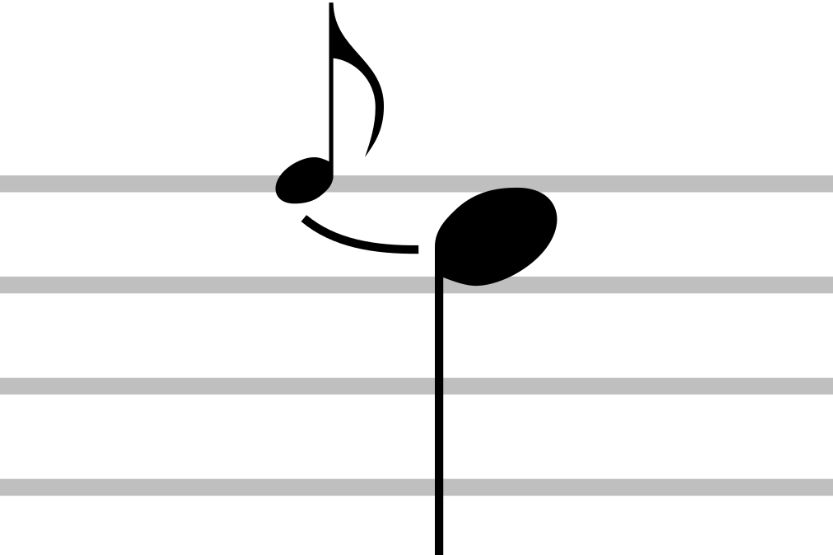
As you learned earlier, there are two types of appoggiatura when it comes to its duration:
1. Long Appoggiaturas
Duration
The duration of this note is half or more of the length of the principal note. Thus, it significantly affects harmony, resulting in a dissonance that resolves (on the principal note) to a consonance.
Dissonance Creates Tension
Dissonance creates “tension” that most of us want to resolve or release. The tension-release theory is one reason a song becomes catchy and popular. Classical and jazz musicians often use dissonance to create pieces that tug at people’s heartstrings.
Stronger Than the Principal Note
The long appoggiatura is stronger than the principal note in terms of accent. It usually falls on the strongest note of the bar.
2. Short Appoggiaturas
Symbol
A short appoggiatura is notated as a small note of small time value that has a slash through the stem. It’s placed near or slurred to the main note or principal note. In the case of the short appoggiatura, the accent typically falls on the principal note itself.
It’s advantageous for a composer or performer that the appoggiatura and acciaccatura are in small print. If it’s the same size as the principal note, there’s a chance that you could mistake it for a passing note.
Musicians play it fast and take only a little time from the principal note. Thus, it doesn’t significantly impact a song’s harmony.
Adds More Color and Emphasis
From time to time, appoggiaturas might drive you crazy and realize they’re useless. Why not write the complete rhythm instead?
There are different opinions about the usefulness of an appoggiatura. One reason is it’s an excellent expressive tool.
The upper appoggiatura repeats the note before the principal note and descends into the principal note. You can compare it to the sound when you’re sighing. In other words, it adds more color and emphasis to capture everyone’s attention.
So, in a way, it is easier to identify which note is essential to the harmony or melody of a piece and which note acts as an embellishment.
Again, what’s the difference between acciaccatura and appoggiatura? In the appoggiatura, the grace note is emphasized while giving time away from the principal note, while in an acciaccatura, the grace note happens before the principal note.
What Is an Acciaccatura in Music?
Musicians Play the Acciaccatura as Fast as Possible
Musicians play the acciaccatura, a grace note, as fast as possible before a melody’s principal note and immediately release it. A slur usually connects the acciaccatura note and the principal note.
Symbol
It’s usually notated as a small eighth note with a diagonal line through its flag or stem. If followed by a regular-sized principal note, the diagonal line means you should slide through the preceding note and immediately follow it up with another note (principal note) on a strong beat.
In modern music, an acciacatura is also the short appoggiatura. Unlike an appoggiatura, it emphasizes the principal note, not the grace note.
No Strict Rule on When Should Musicians Play It
However, there’s no fixed rule on when you should play it, whether right on the beat or before it. The use of it is often dictated by how a piece was performed during the composer’s time and even individual preferences.
The word acciacatura is from the Italian word acciaccare (“to crush”). Musicians also refer to it as a crushed note since you must rapidly switch to the next note.
When you “crush” the note, you roll your wrist inwards to crush or jam into the next note.
There’s no exact time for holding the acciaccatura note. It just needs to be extremely short, like for a millisecond, compared to the length of the real note.
There’s another technique of playing an acciaccatura that can only perform on a piano. Instead of playing the acciaccatura grace note and following it up with the real note, you press down both notes simultaneously. Then, you release the acciaccatura key almost instantly.
An acciaccatura isn’t always played the same way (i.e., it might be played lower, longer, or shorter). If you want to know the correct technique for playing an acciaccatura, it’s a good idea to check the period the piece was written in.
This will give you valuable insight into how the composer wants the piece to be played.
What Is the Difference Between Appoggiatura and Acciaccatura?

Until today, some people still find appoggiaturas and acciaccaturas confusing. One reason for the confusion is how musicians used these tools in the past.
For instance, in the 19th century, some people played the appoggiatura before the beat.
So, what are the differences between an acciaccatura and an appoggiatura? Let’s differentiate the two based on their notation, duration, and placement (i.e., before or on the beat):
1. Notation
An acciaccatura appears on the musical staff as an eight note (also called a quaver) with a slash through its flag and stem. Meanwhile, an appoggiatura is typically written as a small note without a slash followed by a full-sized principal note.
A slur marking attaches both notes. Sometimes, to reduce vagueness, it’s written exactly how it’s intended to be performed—with a full-sized note.
But since the same notation for appoggiaturas is used for other grace note interpretations, it can be tricky to determine if an appoggiatura is intended. The best way to go about this is by knowing how a song is or was performed.
2. Note Duration
During the 16th century, an appoggiatura takes around one-third of the time value of the principal note. But in general, its actual time value will depend on the time value of the real note that follows it.
The real note or principal note could be of any duration. It could be an eight note (played for one eight the duration of a whole note), a quarter note (played for one-quarter of the duration of a whole note), or a 16th note (played for half the time of an eighth note).
So, whichever principal note it is, the time value of an appoggiatura will be far shorter.
An acciaccatura isn’t supposed to take away time from the principal note. In practice, you play the grace note rapidly or play it right before the real note is supposed to be played.
To sum it up, an appoggiatura is typically given its own time and length—around a third of the time value of the principal note. Meanwhile, the acciaccatura doesn’t steal any time from the principal note. It also has no emphasis. It’s played so fast that it’s as if it happened in no time.
3. On the Beat Versus Before the Beat
Today, the consensus is an acciaccatura note lands before the beat. However, this isn’t a definitive rule. How you should play it—on or before the beat—will depend on the individual preference and how a composer wants it to be played.
An appoggiatura always lands “on the beat.” Almost all musical ornaments today are supposed to be played on the beat.
If you spot two notes forming a descending second—one a metrically accented note (naturally emphasized note or beat while playing the piece) and the other in an upward leap (expresses a shot of excitement)—it’s possibly an appoggiatura.
Bass and Treble – Difference Between Treble Vs Bass
Conclusion – Acciaccatura and Appoggiatura Grace Notes
An appoggiatura (played on the beat and emphasizes the grace note itself) and acciaccatura (played before the beat and highlights the main note) are two types of grace notes.
They’re just embellishments to the principal note, so they’re not necessary to the melody or harmony of a song. However, they do make a piece more expressive and interesting. Plus, they allow performers to showcase their virtuosity.
Read next:


